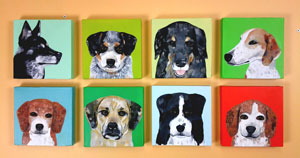What was your first pet?
When I was four, my mom, perhaps in response to nagging from my sister and me, bought us goldfish. We came home with eight goldfish in a tiny one-gallon tank. They all died within 48 hours, due to overcrowding in the tank. I remember realizing that we must have been doing something wrong. I was left with the important lesson that pet ownership is something to take very seriously and to learn to do properly.
Fast forward to more than twenty-five years later—I chose a goldfish to train as my second species subject for the KPA Dog Trainer program! The goldfish was a $1 feeder fish and I put him in a 10-gallon tank, all by himself. No chance of overcrowding this time! Despite my best efforts, he only lived a year. But he was clicker trained.
What led to your interest in dog training?
In 2006, after much consideration about dog ownership, I adopted Duke, my rescue beagle. Instantly, I fell in love with him and I knew I would do anything for him. He had severe separation anxiety and also developed serious on- and off-leash dog aggression. I had no choice but to develop a serious interest in dog training, quickly, to help him.

Andre's rescue beagle, Duke.
Why did you choose Karen Pryor Academy?
As a dog owner living in downtown Toronto, I had long felt that the dog training market was grossly underserved here. When I started taking Duke to group classes, I didn't have a car at the time so we would sneak onto public transit to get to class across town. It would be an hour each way. It seemed odd to me that there weren't good options in my neighborhood, options I could walk to.
When it came time to make a career change, I capitalized on what I considered a great opportunity—the opportunity to open a dog training school in the west side of downtown Toronto. I had already started doing private lessons for friends, family, and referrals, for simple issues. But I wanted to acquire skills and credentials to differentiate myself from everyone else.
After researching all the options out there, including apprenticing with local trainers and attending other schools (some involving boarding, others that were 100% distance-based), KPA was the obvious choice. The brand recognition, broad approval of its methodologies, and perfect balance between hands-on and distance education sold me.
What impact has the KPA program made on you as a dog trainer?
Concepts that were hazy or fuzzy became crystal-clear thanks to the excellent curriculum and instruction. KPA let me slingshot through the dog training learning curve instead of spending years making mistakes.
Your dog training business, When Hounds Fly, is booming. Can you share some of the secrets of your success?
The most important secrets will stay secret, because I learned them from the business curriculum of the KPA Dog Trainer Program. The curious will just have to enroll in the program to find out!
Some of my success is just luck. But my good friends know that I don't believe in dumb luck. I define luck as simply when preparation meets opportunity. I prepared by building a great website, and putting together amazing branding and content. I thought hard about my messaging and I really wanted to speak to a certain type of clientele (me, when I first adopted Duke).
With all that hard work, I also attracted the attention of many other talented dog trainers. One by one, their introductory e-mails would delight me as they appeared in my inbox over time. Julie Posluns and Mirkka Koivusalo joined me in late 2010; Emily Fisher in 2011, and Rachael Johnston in 2012. Mirkka and Rachael are also KPA CTPs. Julie and Emily are CPDT-KA. Many of their talents greatly exceed mine, so I consider myself very lucky!

This series of paintings of instructors' dogs hangs
proudly in the lobby of Andre's training facility.
Without them, When Hounds Fly wouldn't be where it is today. Julie has since moved on to St. John's, Newfoundland, for two years to pursue a master's degree in animal behaviour. I know that Emily's, Mirkka's, and Rachael's own dreams will eventually take them places in the future. I commissioned this series of paintings by Queen of the Cats of the instructors' dogs so I can always remember what an awesome team we are today.
You left a successful career in the software business to become a dog trainer. Do you ever look back?
I used to. Periodically, I'd get news on Facebook or LinkedIn about my former colleagues going off and starting their own technology companies and getting funding, or getting acquired (and getting rich!). It would make me pause and ask why I was working so hard, even though I would not be able to cash out and retire on dog training anytime soon.
Julie Posluns gave me some very helpful advice when I shared my feelings of regret with her. How could I possibly compare what we do to what they do? They help big companies get bigger. Does the world really need a bigger big-box store, or should we really be helping another fast food restaurant get another billion customers in China? Clicker trainers improve peoples' relationships with their dogs, which enriches peoples' lives. That's important.Clicker trainers improve peoples' relationships with their dogs, which enriches peoples' lives. That's important.
Once I put things in perspective, any feelings of self doubt or regret disappeared.
Do you feel that your business background has influenced your outlook as a dog trainer?
Yes, absolutely. I am a small business owner first, and I take financial management very seriously. As a result, I am very disciplined when it comes to charging fair market value for the services we provide and maintaining good margins with the business. This focus enables me to pay myself and pay my staff extremely well as compared to most dog training schools.
A poor dog trainer can't help many people. A homeless dog trainer can't help anyone. Too many dog trainers don't understand that, and end up giving away the farm because they want to help everyone with a dog. They don't stop to think about making sure that they are taken care of first.
You are not only KPA's first CTP in Toronto, but you are also the first CTP to open a chain of training facilities. How is the second training center? Any thoughts about opening a third?
It's going great. Our second location in North Toronto is ramping up much faster than our first location did, since we have so much positive word-of-mouth from more than two years of successful classes already.
While I haven't ruled out opening a third location, I am actually working on other projects now that are taking priority. I have been working hard to get more opportunities to reach the public and spread knowledge of clicker training through the media. This year, I appeared on eTalk Daily (a national news and entertainment daily show) and GlobalTV News, and I am also the official dog trainer for an upcoming reality show on CBC called Over The Rainbow, where they are casting both Dorothy and Toto for an upcoming Andrew Lloyd Webber production of The Wizard of Oz.
In the online and social media world, I partnered with Julie Posluns and started Treatpouch.com, an online/distance learning dog training school. Our Bark and Quiet training video is in the process of going viral on YouTube, and our first online course, Polite Puppy, is available for on-demand enrollment now.
In both cases, I'm interested in reaching more people than I could just through my business When Hounds Fly alone. And, it would be awesome to become famous while I'm at it!
What is your advice for someone wanting to get a dog training business off the ground?

Expansion of original 400 square foot
training
area to 1200 square feet.
A tip I got from Terry Ryan when she visited us during the KPA Dog Trainer Program Workshop 3 in New York was that you don't need that much space for dog training. In Japan it's often done in the vet clinic's waiting room, according to Terry.
Start small and build from there. My first training space was only 400 square feet. I had the opportunity to triple the space and when the time was right, I did.
Among your class offerings are innovative modular classes. What are the benefits of this format?
When Hounds Fly offers Puppy Socialization and Foundation Skills (Beginner's Classes) programs in a modular format. That means the curriculum is taught in a non-linear order—everyone begins the program at different times and ends the program at different times. Compare and contrast this format to conventional linear classes, where a new prospective student must find out when the next session of a program is being held, register in advance to hold a spot, and, possibly, wait a month or longer before starting training.

Andre conquering his fear of heights!
With our modular classes, new clients don't have to wait too long at all; sometimes people start classes within days of filling out an enrollment form. Contacts at different shelters I've spoken with love this option, since they can encourage new adopters to get into classes quickly and start off on the right foot. Sometimes a few extra weeks of waiting can make a big difference. Modular classes mean people get the help they need faster, since there is never a fixed start date to wait for.
Modular classes offer greater flexibility for clients once they are mid-program. Because our school is so popular, we offer classes nearly every day of the week and can accommodate a wide variety of schedules. Summers are short in Toronto, so students here can still take a week or two off to go to the cottage, just doubling up on classes before they leave and after they return to not miss a beat.
We love to talk training with you, but tell us what we really want to know. Living in Toronto, have you done the EdgeWalk at the CN Tower?
I'm getting goose bumps just thinking about it. I have a fear of heights! No, I haven't done the EdgeWalk yet! However, I took our instructors out for an afternoon of rock climbing recently (we were joined by KPA alum, Grisha Stewart) and here's proof. The smile is a nervous one.
Related Products
|
|
|





Post new comment